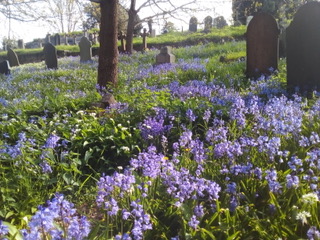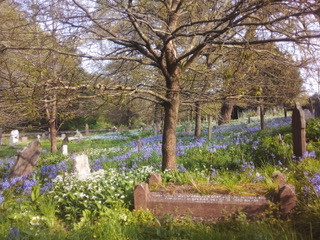Almost half of the world’s Bluebells are here in the United Kingdom and we are blessed to have them here at Ford Park Cemetery.
 The lower valley within the cemetery, which borders Central Park and has a woodland feel to it, has drifts of these deep blue-violet flowers in bloom at the moment.
The lower valley within the cemetery, which borders Central Park and has a woodland feel to it, has drifts of these deep blue-violet flowers in bloom at the moment.Bluebells native to this country (Hyacinthoides non-scripta) are protected by law so they cannot be intentionally picked, uprooted or destroyed.
Bluebells colonies take five to seven years to become established from seed to flower and they take years to recover if they are damaged from being walked upon and crushed.
Early botanists had their own nicknames for Bluebells including Cuckoo boots, wood hyacinth, croutons and witches thimbles. There is folklore and superstition associated with these flowers, for example it was said if you walked into a circle of Bluebells you would become enchanted by fairies.
Modern research is exploring the potential from the natural insect and animal repellant benefits of the Bluebell.
The Spanish Bluebell (Hyacinthiodes Hispanica) is an invasive threat to the native Bluebell.
You can tell the difference between the native and Spanish varieties by studying the flower, stem and leaves.
 The British Bluebell with its sweet strong scent, has narrow individual bells with straight sides and the petals cut back at the edges. The curved stems hold the bells which tend to hang to one side and the narrow leaves are between one and 1.5 centimetres wide. There are also white and pink varieties.
The British Bluebell with its sweet strong scent, has narrow individual bells with straight sides and the petals cut back at the edges. The curved stems hold the bells which tend to hang to one side and the narrow leaves are between one and 1.5 centimetres wide. There are also white and pink varieties. Whereas the Spanish variety has little or no scent, cone shaped flowers which hang all around from the upright stems.
You can do your bit to protect and conserve the Bluebell by never picking them and sticking to the path so that you don't destroy any underfoot.


